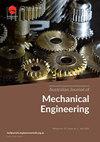Experimental and numerical investigation of the aircraft fuel tank inerting system
IF 1.3
Q3 ENGINEERING, MECHANICAL
Australian Journal of Mechanical Engineering
Pub Date : 2023-08-02
DOI:10.1080/14484846.2023.2241192
引用次数: 0
Abstract
ABSTRACTThe performance of the aircraft fuel tank inerting system is influenced by multiple factors which are strongly coupled. It is a time-consuming process to analyse and evaluate the performance of the system through experiments, and it is difficult to analyse the effects of various factors through limited experimental data. An efficient numerical method is significant for the preliminary design and optimisation of inerting products. In this paper, a generic mathematical model of the hollow-fibre-membrane module (HFMM) was established and the accuracy of the numerical results was verified using experimental data. Based on this mathematical model, a simulation model of the aircraft fuel tank inerting system was developed through cosimulation of AMESim and Matlab/Simulink. The accuracy and applicability of the simulation model for this inerting system were verified using experimental test data. Using this simulation model, the effect of nitrogen-enrich air (NEA) flow rate and aircraft flight altitude on the performance of the inerting system were investigated. The results show that increasing the NEA flow rate contributes to a shorter time for the oxygen concentration to reach a steady state while with a higher stabilised value. The use of a high NEA flow mode is effective in improving the inerting performance during the rapid descent stage.KEYWORDS: Hollow-fibre-membraneair separationfuel inertingefficient numerical methodexperimental study Disclosure statementNo potential conflict of interest was reported by the authors.Author contributionsMethodology: Yi Tu. Software and formal analysis: Yi Tu. Experimental test: Chenhui Du and Yu Zeng. Original draft: Yi Tu. Review and editing: Chenhui Du and Yu Zeng.Data availability statementThe data used for the verification of mathematical model of the HFMM is available upon request https://www.techscience.com/fdmp/v18n2/46015Additional informationFundingThis research was funded by Education Department of Hunan Province, China, grant number 21B0618 and 20C1275. National Natural Science Foundation of China, grant number 52275108.Notes on contributorsYi TuYi Tu, born in June 1984, received his doctor's degree from School of Aeronautic Science and Engineering, Beihang University in July 2011. His current research interests include complex pipeline fluid system of aircraft and heat dissipation technology of high heat flux equipment.Chenhui DuChenhui Du, born in May 1989, received her master's degree from Beihang University in January 2014, and his current research interest is the integrated thermal design of aircraftYu ZengYu Zeng, born in May 1982, received his doctor's degree from Beihang University in November 2020, and his current research interests include aircraft environment control system, aircraft fuel inertization system, and integrated thermal design of aircraft.飞机油箱惯性系统的实验与数值研究
摘要飞机油箱惯性系统的性能受多种因素的影响,这些因素是强耦合的。通过实验来分析和评价系统的性能是一个耗时的过程,并且很难通过有限的实验数据来分析各种因素的影响。一种有效的数值方法对于惯性产品的初步设计和优化具有重要意义。本文建立了中空纤维膜组件(HFMM)的通用数学模型,并用实验数据验证了数值结果的准确性。基于该数学模型,通过AMESim和Matlab/Simulink联合仿真,建立了飞机油箱灌气系统的仿真模型。通过实验测试数据,验证了该系统仿真模型的准确性和适用性。利用该仿真模型,研究了富氮空气流量和飞机飞行高度对吸尘系统性能的影响。结果表明:增大NEA流量,氧浓度达到稳态所需时间更短,稳定值更高;在快速下降阶段,采用高NEA流动模式可以有效地改善惯性性能。关键词:中空纤维膜空气分离燃料惰化高效数值方法实验研究披露声明作者未报告潜在利益冲突。作者贡献:方法学:一图,软件与形式分析:一图,实验检验:杜晨辉,曾宇。原稿:涂毅,审编:杜晨辉、曾宇。本研究由湖南省教育厅资助,批准号21B0618和20C1275。数据可用性声明用于验证HFMM数学模型的数据可查询https://www.techscience.com/fdmp/v18n2/46015Additional信息。国家自然科学基金项目,资助号:52275108。作者简介:图土一,1984年6月生,2011年7月毕业于北京航空航天大学航空科学与工程学院,获博士学位。目前主要研究方向为飞机复杂管道流体系统、高热流密度设备散热技术。杜晨辉,1989年5月生,2014年1月获北京航空航天大学硕士学位,主要研究方向为飞机综合热设计。曾增宇,1982年5月生,2020年11月获北京航空航天大学博士学位,主要研究方向为飞机环境控制系统、飞机燃油惯性系统、飞机综合热设计。
本文章由计算机程序翻译,如有差异,请以英文原文为准。
求助全文
约1分钟内获得全文
求助全文
来源期刊

Australian Journal of Mechanical Engineering
ENGINEERING, MECHANICAL-
CiteScore
3.70
自引率
7.10%
发文量
77
 求助内容:
求助内容: 应助结果提醒方式:
应助结果提醒方式:


